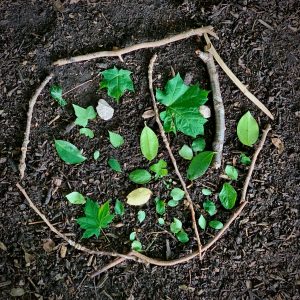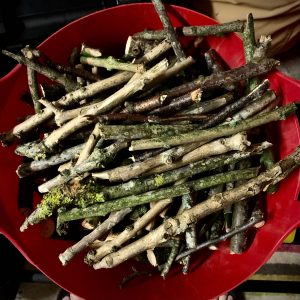Mandala Origins
Have you ever encountered a mandala before? I hadn’t until recently. I discovered their origins lie in the Buddhist religion. A mandala represents what an ideal universe might look like. Dating from as early as the fourth century, mandalas were produced mainly in Asia. Often they were painted and carried by the owner on journeys. Today, they can be found all across the world. One of their uses acts as an aid to meditation. Read more here about the origins and history of mandalas.
I use them in Forest School for a number of reasons. Firstly, they are easy to produce with only a few resources and made year round. Secondly, they are wellbeing friendly, asking the maker to focus, think , consider their creative work and be present in the moment. Thirdly, they are creatively repetitive. Fourthly, using natural materials connects the learner to their physical environment and requires physical effort to make one. Finally, a mandala provides rich cross curricular opportunities within the school environment. Learners work well making their own mandalas, mostly working on an individual basis. Most of the pictures in this post are finished mandalas made by learners.

Little Preparation
Super easy to source and make, mandalas made from natural materials are a fantastic craft for Forest School. Materials can be found on site. They can be reused for multiple sessions in stead of using up new material each time. The mandala I made [see image above] for the session was an example. I encouraged the learners to disassemble mine and make use of it, which they did.

Wellbeing Friendly
Mandalas also have a wellbeing tie in, encouraging the makers to be present in their activity. Planting a thought or idea for leaners to ponder while working is a great tip. I encourage learners to think about something specific or allow them to consider their own thoughts. The end goal is to produce a mandala with a centra focal point which learners can talk about when we review our finished work. Learners are asked to view their peer’s work and offer words of encouragement. Giving and receiving encouragment has a wonderful effect on both parties, affirming the effort given to the activity.

Creatively Repetitive
Is it imperative that the mandala is a circle? The short answer is, no. Once the frame is made, learners progress their mandala by dividing it into segments. This may either be using dividers or separating naturally with the materials. Within each section, they place natural materials in a repetitive pattern until the segment is full. Some mandalas might have lots of one material and less of another. It all depends on the learner’s choice. The learner is the creative director of their work. Artists choose the colours, patterns, items and sometimes even shape of the finished piece.

Physical and Physicality
Making a mandala with natural materials is a physical process. To illustrate, lots of gross and fine motor actions engage to complete the task. Learners have to navigate their environment, bend and pick to choose a leaf, stick or rock. They then transport that material to their place of work. Finally, they move, manipulate and manufacture their marvellous mandala.

Cross Curricular Friendly
Excitingly, a mandala is a great tool for maths. Maths based learning opportunities include: more and less, fractions, patterns, repetition, counting, and quadrants using the x and y axis, to name a few. I mentioned the wellbeing benefits earlier with extensions into PSHE lessons. Weather and seasons offer science related learning. Engagement with English comes from creative writing and describing their creation, the steps of how to make a mandala and writing about the seasons.

Solid All Rounder
Mandala making is a solid all rounder activity for all seasons. Ticking multiple boxes for SPICES [see my article on Five Reasons Forest School Is Great for Kids] mandala making is a ready to go activity at short notice. It’s a supportive activity that can bring focus and being present. It can also provide many opportunities for cross curricular learning.
One final thought. If you have limited materials in your workspace, try preparing some resources in advance ahead of a session.
Want to find out more or participate in a mandala making session? Contact us to book for an upcoming session.
